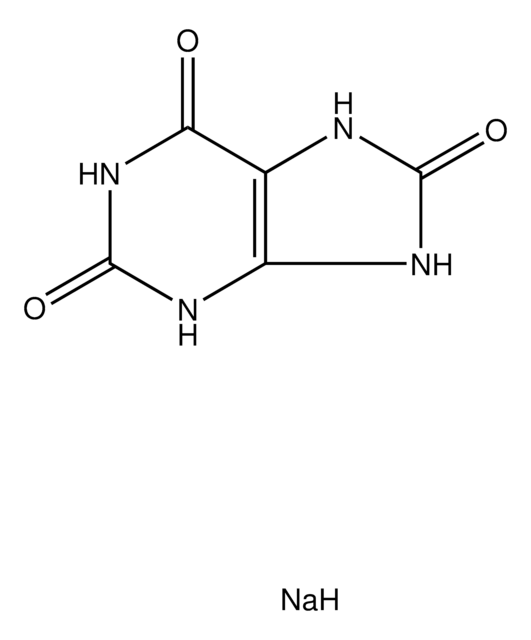U0880
Uricase from Candida sp.
recombinant, expressed in E. coli, lyophilized powder, ≥2 units/mg solid
Synonym(e):
Urate: oxygen oxoreductase
About This Item
Empfohlene Produkte
Rekombinant
expressed in E. coli
Form
lyophilized powder
Spezifische Aktivität
≥2 units/mg solid
Mol-Gew.
35 kDa by SDS-PAGE
Lagertemp.
−20°C
InChI
1S/C18H23N4O14P.H3N/c23-5-7-14(13(28)16(34-7)22-4-2-10(25)20-18(22)30)36-37(31,32)33-6-8-11(26)12(27)15(35-8)21-3-1-9(24)19-17(21)29;/h1-4,7-8,11-16,23,26-28H,5-6H2,(H,31,32)(H,19,24,29)(H,20,25,30);1H3
InChIKey
VPXDHZMLJOJKOX-UHFFFAOYSA-N
Allgemeine Beschreibung
Anwendung
- to eliminate urate in plasma samples and evaluate the contribution of urate to the total plasma antioxidant capacity
- to intraperitoneally inject the mice to study the role of uric acid in fibrin extracellular traps (ET) formation
- for elimination of uric acid in ferric reducing/antioxidative power (FRAP) assay to measure the total antioxidative capacity of human plasma sample; in uricase-based biosensors
Biochem./physiol. Wirkung
Einheitendefinition
Physikalische Form
Lagerklassenschlüssel
11 - Combustible Solids
WGK
WGK 3
Flammpunkt (°F)
Not applicable
Flammpunkt (°C)
Not applicable
Analysenzertifikate (COA)
Suchen Sie nach Analysenzertifikate (COA), indem Sie die Lot-/Chargennummer des Produkts eingeben. Lot- und Chargennummern sind auf dem Produktetikett hinter den Wörtern ‘Lot’ oder ‘Batch’ (Lot oder Charge) zu finden.
Besitzen Sie dieses Produkt bereits?
In der Dokumentenbibliothek finden Sie die Dokumentation zu den Produkten, die Sie kürzlich erworben haben.
Kunden haben sich ebenfalls angesehen
Unser Team von Wissenschaftlern verfügt über Erfahrung in allen Forschungsbereichen einschließlich Life Science, Materialwissenschaften, chemischer Synthese, Chromatographie, Analytik und vielen mehr..
Setzen Sie sich mit dem technischen Dienst in Verbindung.








